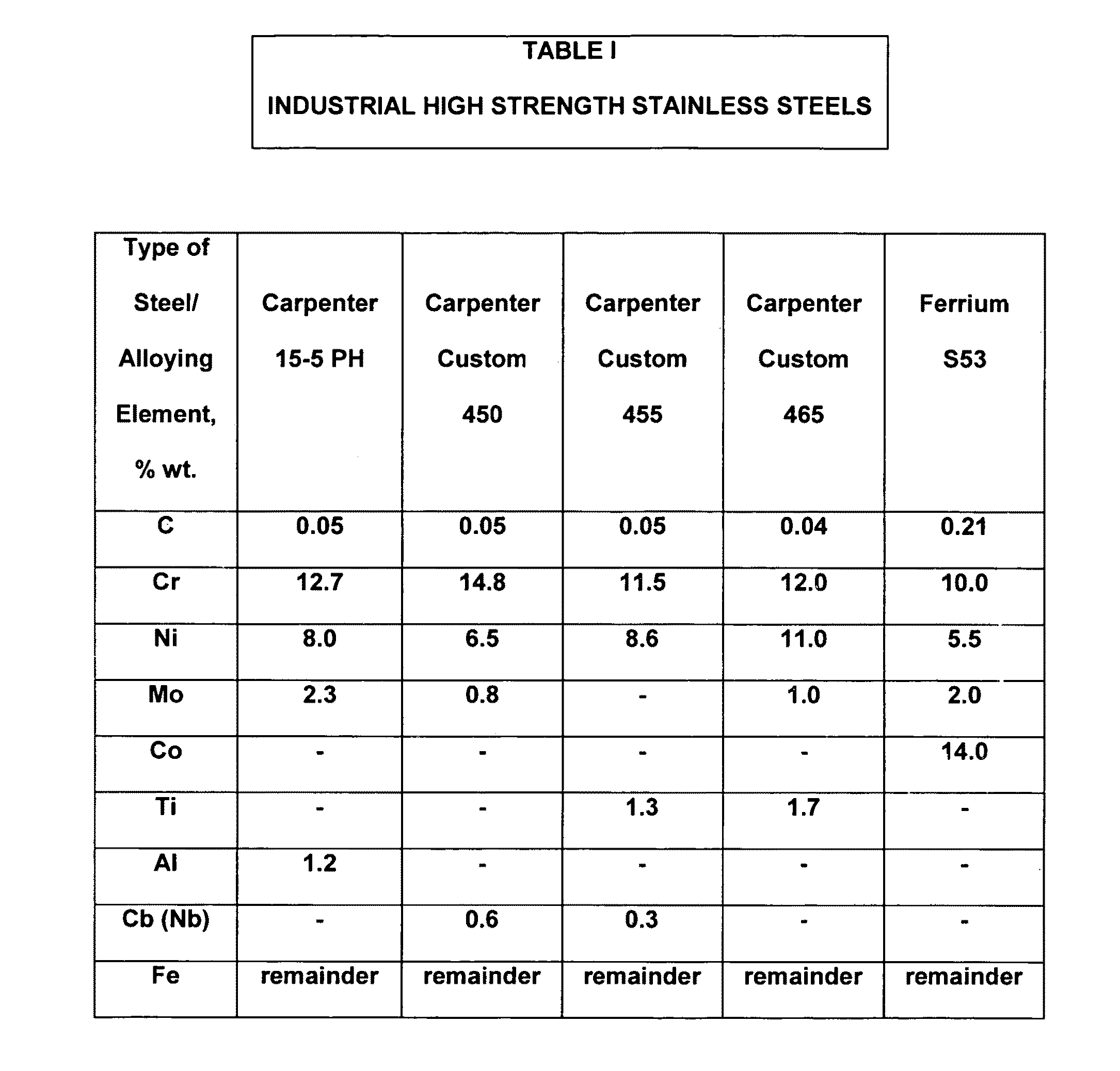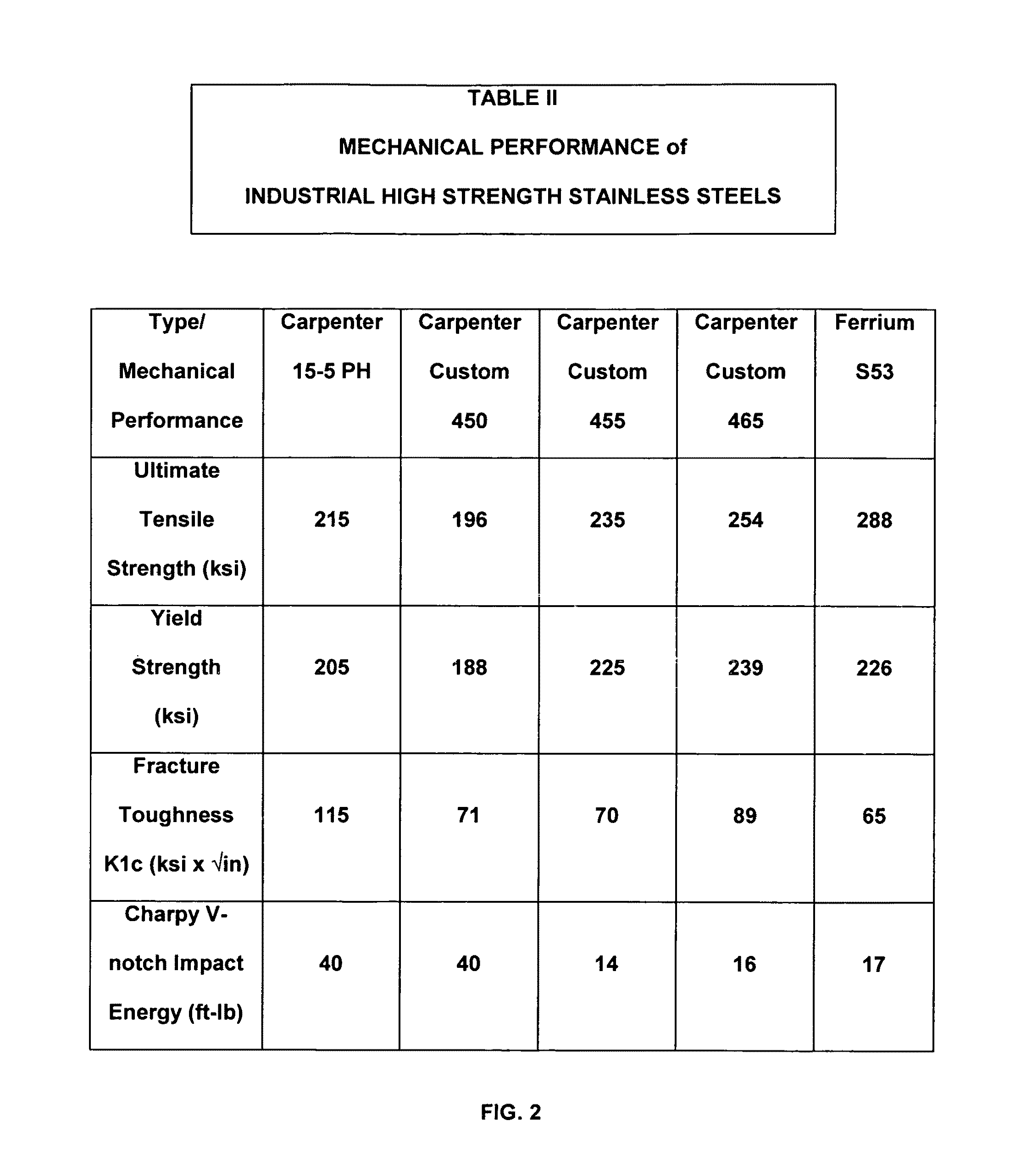Low cost high strength martensitic stainless steel
a high-strength, martensitic technology, applied in the field of stainless steel, can solve the problems of high cost, high cost, alloying elements, etc., and achieve the effects of reducing alloy cost, high strength, and reducing us
- Summary
- Abstract
- Description
- Claims
- Application Information
AI Technical Summary
Benefits of technology
Problems solved by technology
Method used
Image
Examples
example 1
Steel A
[0062]The specimen was comprised by % weight of: 0.37 of C; 2.56 of Ni; 0.78 of Mn; 1.13 of Si; 0.66 of Cu; 8.30 of Cr; 0.97 of Mo; 0.25 of V; 0.11 of Ti; and the balance essentially Fe and incidental elements.
[0063]Machined specimens were subjected to the following heat treatment: austenizing at 1900° F. for 60 min., oil quenched for 2 min., and then air cooled to room temperature; refrigerating at −120° F.; tempering at 350° F. for 3 hours and then tempered at 400° F. for 3 hours.
[0064]Tests of the specimens produced the following results at room temperature.
[0065]
Rockwell HardnessC 53Ultimate Tensile Strength (UTS)290 ksiYield Strength (YS):215 ksiElongation12.1%Reduction of Area36.7%Charpy V-notch Impact Energy20.2 ft-lbSalt Spray Test ASTM 117No significant Red Rust onfor 400 hourspolished surfaces
The microstructure of test specimens is shown in FIG. 5.1.
example 2
Steel A
[0066]The specimen was comprised by % weight of: 0.42 of C; 2.56 of Ni; 0.72 of Mn; 1.07 of Si; 0.66 of Cu; 8.31 of Cr; 0.98 of Mo; 0.27 of V; 0.16 of Ti; and the balance essentially Fe and incidental impurities.
[0067]Machined specimens were subjected to the following heat treatment: austenizing at 1900° F. for 60 min., oil quenched for 2 min., and then air cooled to room temperature; refrigerating at −120° F.; tempering at 350° F. for 3 hours and then tempered at 400° F. for 3 hours.
[0068]Tests of the specimens produced the following results at room temperature.
[0069]
Rockwell HardnessC 55Ultimate Tensile Strength (UTS)297 ksiYield Strength (YS):220 ksiElongation11.7%Reduction of Area34.5%Charpy V-notch Impact Energy17.8 ft-lbSalt Spray Test ASTM 117No significant Red Rust onfor 400 hourspolished surfaces
[0070]The microstructure of test specimens is shown in FIG. 5.2.
example 3
Steel A with Sn
[0071]This test was done to determine the effect of tin (Sn) on the new steel.
[0072]The new steel was comprised by % weight of: 0.38 of C; 2.60 of Ni; 0.73 of Mn; 0.34 of Si; 8.08 of Cr; 0.99 of Mo; 0.26 of V; 0.16 of Ti; and the balance essentially Fe and incidental elements.
[0073]Machined specimens were subjected to the following heat treatment: austenizing at 1850° F. for 60 min., oil quenched for 2 min., and then air cooled to room temperature; tempering at 350° F. for 3 hours.
[0074]Tests of the specimens produced the following results at room temperature.
[0075]
Rockwell HardnessC 53Ultimate Tensile Strength (UTS)284 ksiYield Strength (YS):200 ksiElongation12.0%Reduction of Area31.4%Charpy V-notch Impact Energy14.0 ft-lbSalt Spray Test ASTM 117No significant Red Rust onfor 400 hourspolished surfaces
The microstructure of test specimens is shown in FIG. 5.3.
PUM
| Property | Measurement | Unit |
|---|---|---|
| Charpy V-notch impact toughness | aaaaa | aaaaa |
| Charpy V-notch impact toughness | aaaaa | aaaaa |
| yield strength | aaaaa | aaaaa |
Abstract
Description
Claims
Application Information
 Login to View More
Login to View More - R&D
- Intellectual Property
- Life Sciences
- Materials
- Tech Scout
- Unparalleled Data Quality
- Higher Quality Content
- 60% Fewer Hallucinations
Browse by: Latest US Patents, China's latest patents, Technical Efficacy Thesaurus, Application Domain, Technology Topic, Popular Technical Reports.
© 2025 PatSnap. All rights reserved.Legal|Privacy policy|Modern Slavery Act Transparency Statement|Sitemap|About US| Contact US: help@patsnap.com



